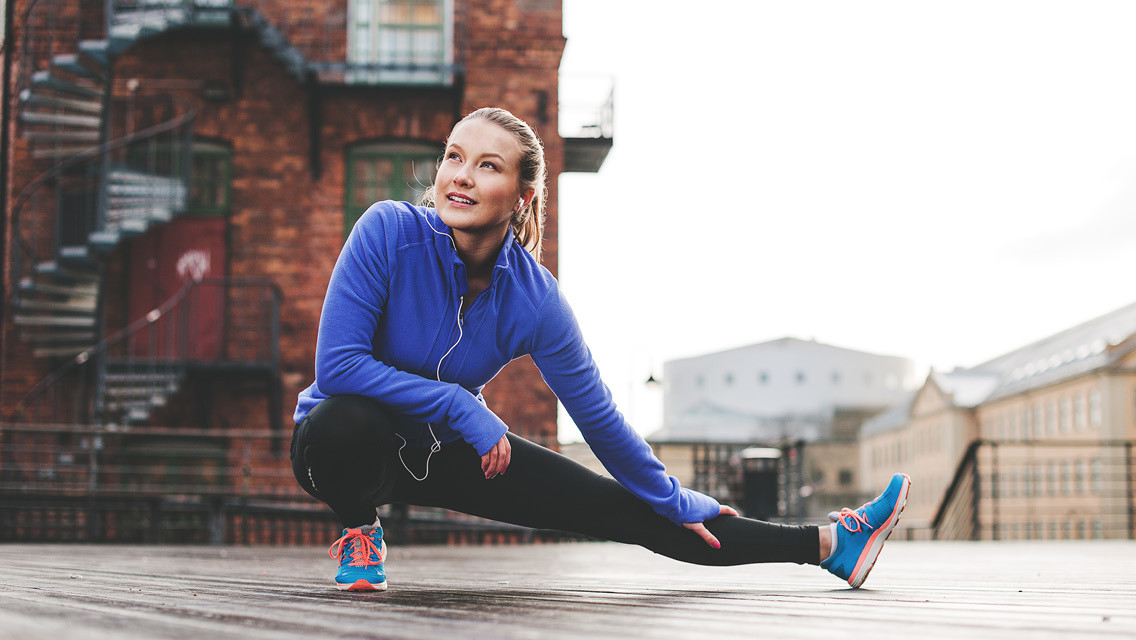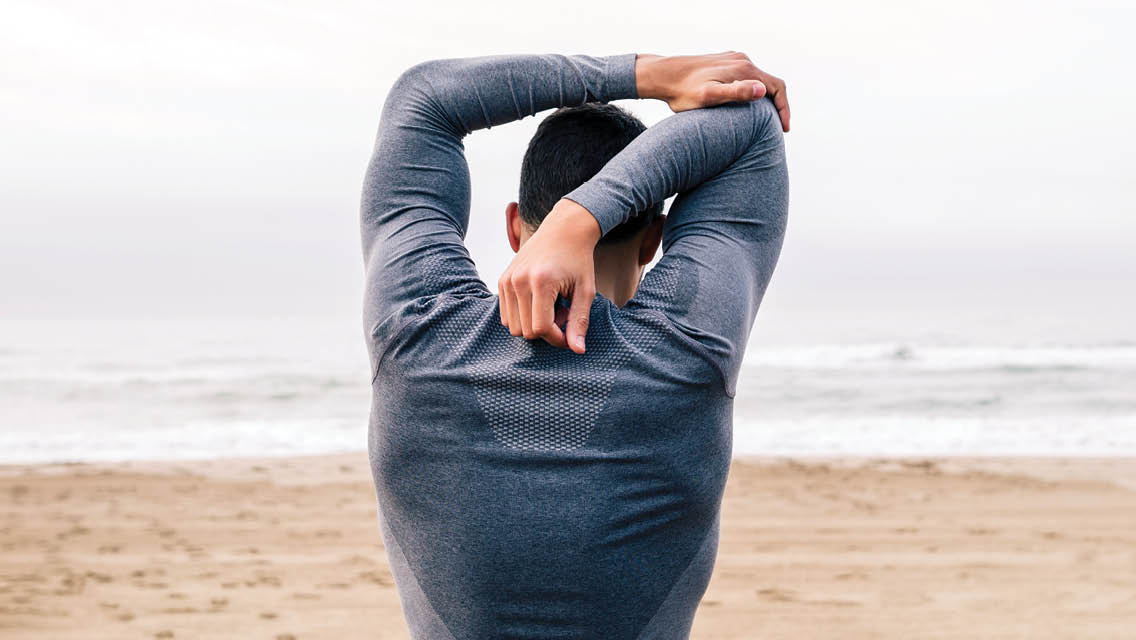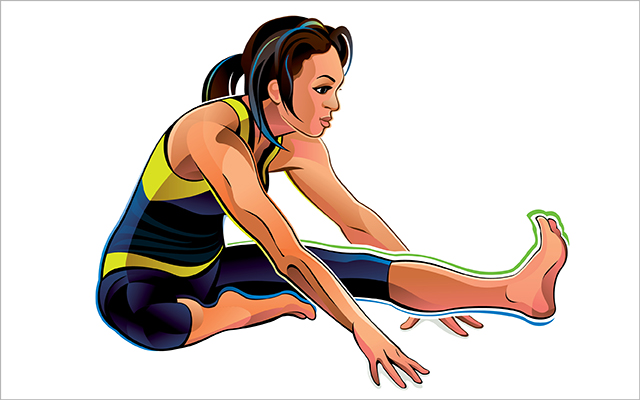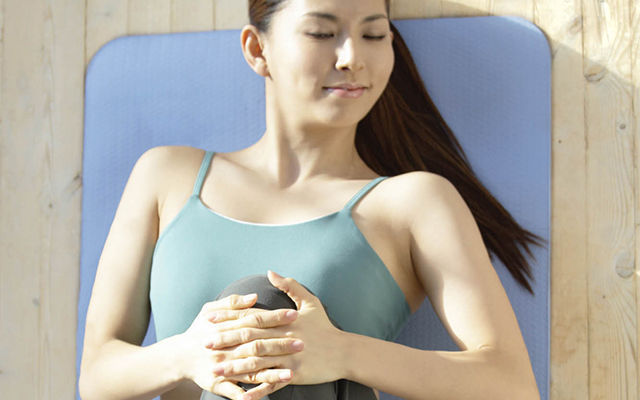Ask most active people if they believe they should stretch before and after their workout, and they’ll likely answer with a resounding “Yes!” (Whether or not they comply is another matter.) Certainly we’ve heard that preworkout stretching prevents injury and gives us a performance boost. And it’s almost gospel that stretching immediately after activity prevents soreness.
In recent years, however, these commonly held beliefs have come under fire. In 2004, a report published by the American College of Sports Medicine (ACSM) questioned the efficacy of stretching, noting that more than 350 studies conducted over four decades had failed to establish that stretching prior to activity prevents injury. To date, studies have also failed to prove that stretching after exercise prevents muscle soreness. “In the fitness industry, we’ve been using perceived notions about when to stretch — without evidence,” says ACSM spokesperson Michael Bracko, EdD, CSCS.
But that’s not to say stretching is good for nothin’: Studies do seem to indicate that a general stretching program may decrease injury and improve performance. (A proper warm-up and cool-down can also boost performance and decrease injury. For more information, see “Gradual Is Good”.)
Still confused about when and if you should stretch? So were we — so we put some questions to fitness experts and researchers in an effort to clear up some of the controversy.
The Long and Short of It
Muscle (and its related tissue, fiber and cells) is elastic in nature. It can expand to a point, and then it returns to its resting, or shortened, state. Any activity requires muscles to stretch to a certain degree; how much depends on the activity. When muscle is stretched regularly, it develops the ability to stretch farther, and the affiliated joints increase their range of motion. This is what we refer to as flexibility.
When muscles aren’t stretched often, they stay shortened and the related joints become less mobile, decreasing your range of motion. This is referred to as inflexibility.
But how does flexibility affect fitness? That’s the big question, and there’s no simple answer. To begin to understand the connection, it’s helpful to examine two of the main reasons that active people stretch: to prevent injury and to enhance athletic performance.
Stretching and Injury Prevention
Q1: Does stretching immediately prior to exercise prevent injury?
A: Anecdotally, yes. But scientifically, signs point to no.
Whether you run, play tennis or lift weights, you probably do some kind of stretching prior to your workout with the belief that you’ll reduce your chances of injury. “Anecdotally, few people would say this intuition is wrong,” says Stephen Rice, MD, PhD, program director of the Jersey Shore Sports Medical Center in Neptune, N.J.
Some experts, however, say you’re wasting your time — or that your time would be better spent warming up. Ian Shrier, MD, PhD, an associate professor in the Department of Family Medicine at McGill University in Montreal and past president of the Canadian Academy of Sport Medicine, is one of them. He notes that, in 2000, research published in the British Journal of Sports Medicine found that most activity-related injuries occur while muscle is contracting during a normal range of motion — not when it’s in an extended position. “If injuries usually occur within normal range of motion, why would an increased range of motion prevent injuries?” he asks.
Bracko concurs. “Injury happens when muscle fails or because of high-velocity eccentric contraction,” he says. “Stretching to make a muscle longer won’t help that.” What will? An effective warm-up, particularly one that includes a few dynamic flexibility drills (controlled movements done through full range of motion), can increase coordination and muscle response time. These dynamic flexibility drills also help lubricate joints and increase muscle temps, and, according to many fitness experts and athletes, serve as an exception to the preworkout “don’t bother” rule, especially when done in conjunction with other warm-up activities, such as light cardiovascular exercise.
Still, warns Shrier, stretching can cause cellular damage, weakening muscle for a time. And it has an analgesic, or pain-relieving, effect, masking pain that might otherwise serve as a warning to stop activity before further injury occurs.
Q2: Does stretching after exercise prevent tightness?
A: Yes, it can help you maintain status quo.
Stretching after exercise will help restore muscle to its resting state, essentially allowing you to maintain your current level of flexibility, says Michael Boyle, strength-training and conditioning coach of the Boston University men’s hockey team. “If you work out hard, the muscles are repeatedly contracting, and you will feel tight. So if you stretch immediately afterward, you are restoring that length.” This type of stretching won’t, however, lead to flexibility gains.
Q3: Does stretching after exercise prevent soreness?
A: Nope.
Although a popular reason for postexercise stretching is the belief that it will prevent sore muscles the next day, scientists say this just isn’t true. The delayed-onset muscle soreness (DOMS) you experience in the days after hard exercise is caused by damage such as microtears to tissue, Bracko explains. “Stretching doesn’t help repair damaged tissue,” he says. Stretching’s analgesic effect will grant you some temporary pain relief from already-sore muscles, but only time will really heal them. (For tips on conquering DOMS, see “Sore Winner”.)
Q4: Does a general stretching program help prevent injury?
A: Evidence looks promising.
Shrier and others found that general stretching programs, such as those incorporated into most yoga practices, when done regularly over time (as opposed to before or after any specific fitness activity), do appear to help prevent injuries. These results come as no surprise to athletic yogis such as Sage Rountree, a triathlete and yoga teacher based in North Carolina. “People experience a total increase in flexibility and fewer overuse injuries when they stretch on a regular basis,” she says.
“Being inflexible, as many fitness enthusiasts are, can lead to overuse injuries, such as patella-femoral syndrome [runner’s knee] and lower-back and shoulder pain,” says Boyle. It stands to reason, then, that if you improve your flexibility, you may be able to avoid such injuries.
Q5: Can overstretching cause any problems?
A: Yes, mostly to connective tissue.
“Connective tissue [like your tendons and ligaments] is damaged when stretched beyond its limits,” says Shrier. Some sports physiologists note that bouncing, especially, tugs on tendons and insertion points instead of lengthening the muscle itself. This can lead to hypermobile joints and muscle imbalances.
Listen closely to your body, says Bracko. “You’re probably overstretching if, instead of feeling good, it’s uncomfortable both during the stretch and afterward.”
Stretching and Performance Enhancement
Q6: Will stretching just prior to activity improve my sports performance?
A: No — and some experts say pre-exercise stretching may even hinder performance.
When muscle stretches during activity, it causes an automatic spring-back contraction, called the stretch reflex, which gives you a burst of power. (Plyometric exercises are based on this mechanism. For more on plyos, see “Elastic Energy”.) Shrier found that stretching just prior to activity might hamper that reflex and decrease the amount of force your muscles can produce when, say, jumping.
“Stretching desensitizes the stretch reflex,” explains fitness expert Pavel Tsatsouline, author of Power to the People: Russian Strength Training Secrets for Every American. “When a muscle is stretched and held for the purpose of lengthening it, it retains that length for a period of time, and when a muscle is too long, you don’t have as much strength.”
Q7: But will a general stretching program help improve my performance?
A: Signs point to yes.
Scientists don’t understand exactly how a general stretching program improves performance, but Shrier says preliminary research indicates that when muscle is stretched regularly, it becomes stronger and contracts more rapidly, resulting in increased force and speed.
A recent Louisiana State University study provides evidence of this mechanism at work. Researchers divided 38 sedentary people into two groups. Over a 10-week period, one group didn’t do any stretching, while the other group performed a series of leg stretches for 40 minutes, three times a week. By the end of the study, those in the stretching group had improved their flexibility, increased their leg strength and experienced improvement in their muscular endurance. The nonstretching group exhibited none of these improvements.
A general stretching regimen also can increase your sport-specific range of motion, which is key to performance gains. Swimmers, for instance, need to be able to move their shoulders through a broad range of motion to perform a stroke; golfers must be able to twist their torsos while propelling their arms back and then forward to swing. “The solution is to become more flexible where ˙ you need more flexibility,” says Boyle. “That’s the key: to know what needs length and what to do to gain it.”
Support for Standalone Stretching
Standing by your preworkout stretching routine? That’s fine. But if that’s the total extent of your stretching, or if you’re not stretching at all, you may also want to consider making stretching a bigger part of your life — and a standalone element of your fitness routine.
The key, it seems, is to think about flexibility work not as an add-on element of your cardio or strength routine, but rather as a distinct aspect of your total conditioning program. (After all, flexibility is often regarded as one of the three pillars of physical fitness, along with cardio conditioning and strength training.) In other words, while it’s definitely worth your time to restore your muscle length with a stretch after your workout, you should also consider a general stretching routine as its own workout, to be done separately.
The benefits you’ll reap from cultivating flexibility are numerous: You can elevate your overall fitness, improve performance and possibly reduce your risk of injury. The trick, as Boyle points out, is to figure out what you need to stretch.
Experts say that stretching for 20 minutes three times a week will help alleviate the tightness and overuse patterns brought on by daily activities.
Stretching can counteract stiffness from spending time in chronic, repetitive positions, which leave muscles in a shortened state. People who sit at a computer every day, for example, would benefit from regular stretching to extend the shortened muscles in the front of the body and prevent compensation patterns from forming (such as a stooped neck or slumped shoulders). Stretching programs prescribed by physical therapists are often designed to address such common structural maladies.
Experts say that stretching for 20 minutes three times a week will help alleviate the tightness and overuse patterns brought on by daily activities. And doing even a single hourlong yoga class or a flexibility-focused group-fitness class each week can also help you build general flexibility. You may also want to consult an exercise physiologist or certified personal trainer to plan a program specifically for you.
The most important message here is this:
Don’t let the confusing details of all the stretching studies put you off stretching entirely. Just pick the flexibility-building options that work best for you, and do them regularly.
Stretching Tips
|
|
Which Type of Stretching Is Right for You?
Experts offer dozens of conflicting claims about which kind of stretching is best. And there are, in fact, many effective ways to stretch, says Michael Bracko, EdD, CSCS, a spokesperson for the American College of Sports Medicine. The exception is ballistic stretching, which involves bouncing and is no longer recommended by sports physiologists because it can increase your risk of injury.
If you’d like to improve your flexibility, Bracko says static stretching may be the best — and most common — application, but most experts admit there’s no one stretching solution that applies to everyone. Choose whatever technique feels best for you as part of a general stretching program. Here’s the lowdown on a few popular techniques:
When performing this slow stretch, you hold at the point of tension for a period of time — from 10 to 30 seconds — and then release. Toe touches and yoga are good examples of static stretching, which experts recommend as part of a regular stretching program that can increase overall flexibility for any active person. It’s not recommended directly prior to activity, however.
Isometric stretching is a type of static stretch during which you reach until you can go no farther, tense and relax the target muscle, and then reach a bit farther. This technique improves range of motion (ROM) and is good for rock climbers and people who pursue similar activities, says fitness expert Pavel Tsatsouline, author of Power to the People: Russian Strength Training Secrets for Every American.
Active Isolated Stretching
This technique isolates and stretches a specific muscle to the point of slight tension, holds it for a second or two, and then releases it. The movement is repeated as many as 12 times at slightly different angles, or until you stretch the muscle to the desired state. Aaron Mattes, developer of the Mattes Method of Active Isolated Stretching, says this technique will benefit athletes in any endeavor, from tennis to football. For more on the Mattes Method, see www.stretchingusa.com.
Proprioceptive Neuromuscular Facilitation (PNF)
PNF was developed as a therapeutic technique. Although successful at increasing flexibility, ROM and strength, if done incorrectly, PNF can put too much stress on the intended muscle group and lead to soft-tissue injury. Usually done with a partner, PNF stretches the muscle to the point of slight tension, then holds it in isometric contraction for about six seconds before relaxing it.
With the muscle relaxed, your partner moves it passively through a greater ROM for up to 30 seconds before you start the process again. (Your partner can also do this when the muscle is held in contraction during the initial stretching phase.) PNF stretching shouldn’t be used by athletes recovering from surgery, anyone with an unstable joint in the area where the stretch is being applied, or anyone younger than 18, since it may disrupt muscle growth. (See “The PNF Workout” for more.)
This is stretching in motion. One kind of dynamic stretch involves gradually increasing ROM and speed of movement with a controlled swing that reaches the limits of your ROM. (Leg swings and arm circles are examples.) Other kinds of dynamic stretches are aimed at increasing muscle response time and improving running form; these are often labeled as dynamic warm-up activities rather than stretches, per se, and may be done prior to a workout. According to Tsatsouline, these dynamic activities are good for people whose sports involve running.
How to Personalize Your Stretching Program
Research and anecdotal evidence tell us that engaging in a general program of stretching is your best bet for avoiding injury and improving sports performance. Doing yoga is one way to loosen up your muscles and joints, but you can also create your own customized program.
Ann Frederick, flexibility specialist and coauthor of Stretch to Win, suggests tuning in to your body and learning what it needs. For example, you are probably tighter on one side than the other. “Folks tend to stretch the same way on both sides of their body even though they are usually tighter on one side,” she says. “You should think about what your fitness activity or sport requires, and also think about the positions that your daily activities require you to be in, and balance yourself from there by spending a little more time stretching the tighter areas.”
“You should think about what your fitness activity or sport requires, and also think about the positions that your daily activities require you to be in, and balance yourself from there by spending a little more time stretching the tighter areas.”
For most people, the muscles in the front of the body — the pectorals, biceps, abdominals and hip flexors — are in a chronically shortened state. Any general stretching program should aim toward balancing these areas. “People should be thinking about getting themselves upright,” says Michael Boyle, strength-training and conditioning coach of the Boston University men’s hockey team. (For ways to combat common muscle imbalances, see “Office Imbalance”.)
To learn more about how to create a stretching program specific to you, consult an exercise physiologist or personal trainer.
This article originally appeared as “Stretch and Reach: The Unexaggerated Truth About Stretching”.




This Post Has 0 Comments